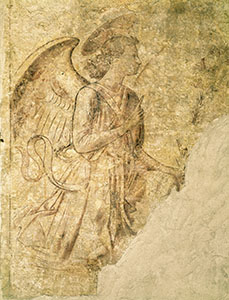
The Annunciation (sinopia painting), Camposanto (Graveyard), Pisa.
To create a fresco, the painter began by coating the wall with a layer of plaster, which was made by mixing water with slaked lime, and large-grained river sand. This first layer, about one centimeter thick, is called the arriccio (rendering). The roughness of this surface promotes the adhesion of the second layer of plaster. The artist drew the preparatory drawing directly on this first layer. With a piece of charcoal - easily erasable - he first penciled in the design. Once satisfied with this drawing, he used earth-ochre to trace a second set of lines alongside the charcoal lines. A bunch of feathers was then used to brush away the charcoal lines, and a red earth pigment was used to draw over their faded yellow remnants and to flesh out the details of the representation (folds of drapery, faces, chiaroscuro, etc.). This technique, first introduced in the thirteenth century, was used during most of the fourteenth century for large preparatory drawings. Today sinopia painting is named after the reddish pigment (originally from the city of Sinope) used to execute the technique.
Once the sinopia painting was finished, the actual painting could begin. At this point a new layer of plaster, the ‘intonachino' (thin plaster layer) was spread over one area of the arriccio (rendering) to prepare a perfectly smooth surface to receive the coloring. Intonachino (thin plaster layer) is a thin, transparent layer composed of one part slaked lime and two parts finely-ground sand. It was only applied to the surface area the artist expected to be able to color during one day's work, because the surface must be humid during the coloring phase. Then the painter used a brush to trace over the sinopia painting outline, which remained visible through the thin layer of intonachino (thin plaster layer). At last, he began painting with grounded pigments mixed in water.
Serena Nocentini